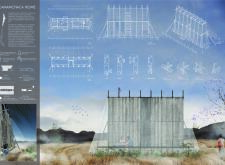5 key facts about this project
Unique Features and Functionality
The Camanchaca Home is characterized by its efficient spatial organization, which includes distinct zones for eating, working, resting, and grooming. This layout fosters a sense of community while maximizing usability. The use of wood as a primary structural material not only emphasizes sustainability but also creates a warm atmosphere. Reinforced concrete is deployed strategically to provide stability and durability against local weather conditions.
One of the most notable aspects of this project is its façade, which integrates cloth material. This choice allows for a unique interaction with the environmental elements, enabling air circulation while protecting against the elements. The translucent quality of the fabric is designed to capture moisture from the fog, facilitating passive water collection—a feature that further highlights the project's commitment to environmental sustainability.
Adaptive Design Principles
The design approach taken in the Camanchaca Home reflects adaptability and future growth potential. The modular configuration allows for spatial reconfiguration in response to changing community needs. The elongated form of the building, coupled with a sloped roof design, contributes to efficient water drainage and wind resistance, ensuring that the structure remains resilient over time.
The strategic orientation of the house enhances energy efficiency and natural lighting, which is a consideration that speaks to its environmental integration. The project balances modern architectural methods with traditional building practices, reinforcing its connection to the local context and culture.
For a comprehensive analysis of the architectural principles and materials used within the Camanchaca Home, including detailed architectural plans, sections, and design ideas, readers are encouraged to explore further. Such an examination provides deeper insights into the successful melding of functionality and sustainability embodied in this architectural project.























